DACF Home → Bureaus & Programs → Maine Natural Areas Program → Communities, Plants, and Animals → Invasive Plants → Yellow Iris
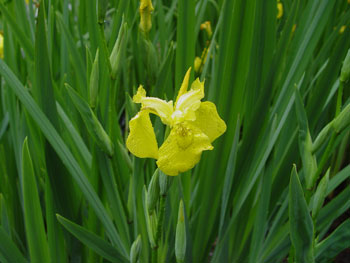 Yellow iris
Yellow iris
Yellow Iris
(Yellow flag)
Iris pseudacorus
2019 Status in Maine: Localized. Severely Invasive.
Description: Robust, perennial monocot forb. Leaves: Sword-like, flattened , with parallel venation; ¾ - 1¾" wide and up to 3½' long. They arise fan-like from thick rhizomatous rootstock. Roots: Thick rhizomes, black sap. Flowers: Large yellow flowers have three drooping sepals with brown markings. 3-4"diameter. 2-10 per stalk. Blooms May through July. Fruit: Large 1½-4" capsules. Two rows of flat disc-shaped seeds line each of the three chambers inside the capsule.
Native range: Europe, Western Asia, North Africa. How arrived in U.S.: As an ornamental.
Reproduction: By rhizome fragments and seed. Dry rhizomes remain viable for months. Individual rhizomes may live 10 years. Seeds float, longevity not known. 20% of seeds dispersed in October will germinate the next spring.
Habitat: Wetlands. Prefers nutrient rich soil. Plant is sometimes used on purpose in remediation to trap sediments and heavy metals. Occurs beside ponds and lakes as well as in freshwater, salt, and brackish tidal marshes. Can grow in open wetlands or under a tree canopy in forested wetlands.
Similar native species: Leaves can be confused with cattail (Typha spp.) or native blue flag (Iris versicolor).
Similar non-native species: Other ornamental irises species. Yellow iris is the only completely yellow, large wild iris naturalized in North America. Siberian iris has narrower leaves and blue flowers.
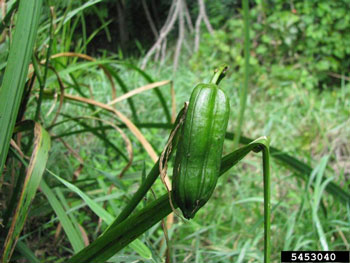 Yellow iris fruit, Leslie J. Mehrhoff, University of Connecticut, Bugwood.org
Yellow iris fruit, Leslie J. Mehrhoff, University of Connecticut, Bugwood.org
Fact Sheets and Identification Links
- Ontario's Invading Species Awareness Program - Yellow Iris
- Go Botany page for Iris pseudacorus
Control Methods
Cannot be grazed; plants contain glycosides. It can be dug (wear gloves). Bag and discard plant in garbage*. A combination of mechanical and chemical treatment works well†. Aquatic-formulated glyphosate is most widely used. Late-season applications are most effective, but if seeds are present, consider manually removing them and disposing in trash to prevent their dispersal, especially along waterways. For small infestations, us a glyphosate solution in a dripless wick applicator and apply to folds of leaves. For larger infestations, foliar applications are effective when applied late in the growing season (after flowering is complete) until just after first fall frost. Special rules apply to herbicide use in or near wetlands and water bodies - consult the Maine Board of Pesticides Control.
* Correctly dispose of all plant parts↵ † Follow all label directions when using herbicides↵Control Technique Video Demonstrations
- Sea to Sky Invasive Species Council, British Columbia (1:42), hand pulling, use caution and do not spread rhizome fragments, contain any parts you pull so rhizomes are not spread, especially in moving water systems
Please email invasives.mnap@maine.gov if you have questions about invasive species in Maine
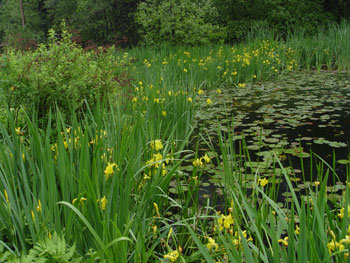 Yellow iris infestation
Yellow iris infestation
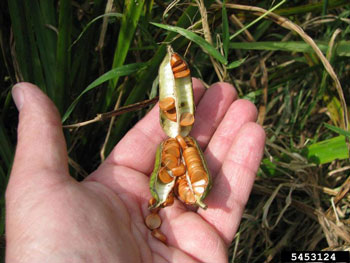 Yellow iris seeds, Leslie J. Mehrhoff, University of Connecticut, Bugwood.org
Yellow iris seeds, Leslie J. Mehrhoff, University of Connecticut, Bugwood.org
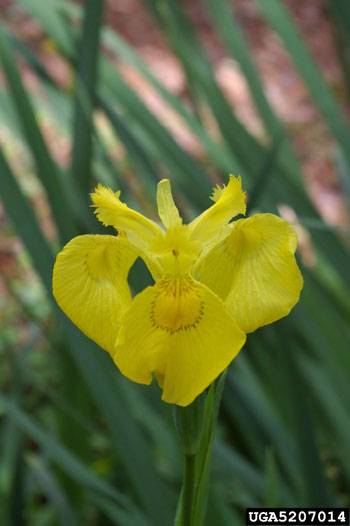 Yellow iris flower, Nancy Loewenstein, Auburn University, Bugwood.org
Yellow iris flower, Nancy Loewenstein, Auburn University, Bugwood.org